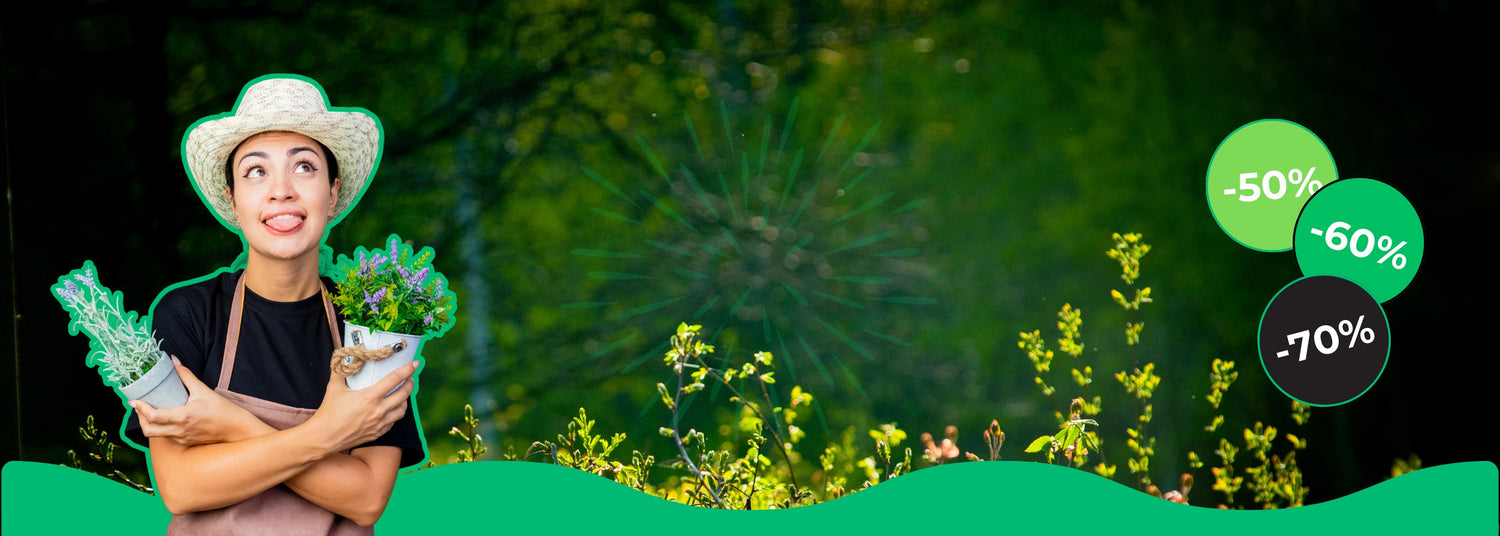GARDEN SOIL 101: THE KEYS TO A FLOURISHING GARDEN 🌱

Gardeners often overlook the impact soil can have on the health and vitality of their plants.
Preparing the soil may not be the most exciting aspect of creating a garden, but it is undoubtedly one of the most important.
If your soil is not suitable, your garden will struggle to reach its full potential.
“A garden is a reflection of the quality of its soil. Gardens with quality soil have a vitality that you can almost feel,” explains landscape designer and author Jan Johnsen.
To achieve this vitality, it is essential to understandthe chemistry and composition of your soil,as well as creating the perfect environment for fertile plant growth.
Good soil management is an ongoing process, but once the basics are in place, your soil will do most of the work for you.
6 Basic Principles for Healthy Soil 🌿
-
Know your Soil Type 🧬
Each type of soil has its own characteristics.Sandy, clayey or loamy,it is crucial to understand the nature of your soil to best meet the needs of your plants. -
Test the pH of your soil 🔬
pH influences the availability of nutrients in the soil. A simple pH test will let you know if your soil is too acidic, too alkaline, or just right for your crops. -
Amend with Organic Matter 🍂
Adding compost, manure or dead leaves improves the structure of the soil, increases its capacity to retain water and enriches its fertility. -
Relying on Microorganisms 🦠
Microorganisms are the invisible allies of your garden. They break down organic matter,releasing essential nutrients for your plants. -
Mulch with Care 🌾
Mulching helps conserve moisture, regulates soil temperature and reduces weed growth. Choose the right mulch for your garden to maximize its benefits. -
Promoting a No-Till Approach 🌾
Heavy tillage can disrupt soil structure and beneficial microorganisms. Opt for a no-till method topreserve the natural health of your soil.
1- Know Your Soil Type 🌍
Before you start planting, take a handful of soil and examine its texture. Is it dense, heavy, and compacts when wet? Or is it light and fluid, like play sand? Maybe it's somewhere in between, slightly sticky but crumbling easily, like a freshly baked cookie.
All soils are a mixture of mineral particles — mainly clay, sand and silt. Often, a soil will contain a higher proportion of one particle type compared to the others. This doesn't mean it's bad for the crop, but it will affect its density, drainage capacity, and ability to retain nutrients.
Each type of soil has its advantages and disadvantages. Here is a brief overview:
- Clay soils contain tiny, dense particles that hold large amounts of water and nutrients. However, they drain slowly and can become hard and compacted when dry
- Sandy soils are the opposite, with large particles through which water moves easily, often carrying away essential nutrients.
- Loamy soils have fine particles that clump together, limiting drainage and air circulation.
- Loam is the ideal soil for most plants; it contains a balance of all three types of mineral particles and is rich in humus (what remains after organic matter decomposes).
Adding organic matter is the best way to make your soil more loam-like and improve its structure.
Another option is to build a raised garden bed and fill it with a well-balanced soil mix.
Or you can simply choose plants suited to your soil type, such as drought tolerant plants for sandy soils.
You can successfully create a garden in anysoil typeas long as the plant roots are adapted to the conditions. 🌱
2-Test the pH of your soil 🌡️
The pH of your soil is one of the most important factors in determining its fertility.
If your soil is too alkaline (with a pH above 7.5) or too acidic (with a pH below 5.5), this can greatly influence the availability of nutrients to your plants. plants.
Although most plants tolerate a wide range of pH levels, they generally prefer slightly acidic soils (with a pH of 6 to 7) because essential nutrients like nitrogen, phosphorus, potassium, calcium and Magnesium dissolves more easily in this environment.
In soils that are too acidic or too alkaline, your plants may receive too much of some nutrients and not enough of others.
How to test the pH of your soil? Here are two options:
- DIY Soil Test Kit 🧪: For quick results, you can purchase an instant test kit or electronic tester (like this one on Amazon).
- Professional Soil Analysis 🧫: If you are starting a new garden, it is a good idea to have your soil tested professionally. The soil samples will be sent to a laboratory, which will analyze the pH, nutrient content and nutrient retention capacity of your soil. Try the Soil Savvy Test Kit, also available on Amazon.
Be sure to take soil samples from different locations throughout your garden, as pH can vary greatly even in a small space.
If your pH reading is low (acidic), you can correct it by adding lime to your soil.
If it is too high, add powdered sulfur or aluminum sulfate. Another option is to choose plants that thrive at your soil's natural pH, such as rhododendrons or azaleas, which like acidic soil. 🌸
3- Amend with Organic Matter 🍂
Any type of soil can be improved by adding organic matter.
Here are three common amendments:
- Composted garden waste ♻️
- Manure 🐄
- Dead leaves 🍁
In sandy soils, organic matter improves water and nutrient retention capacity.
In clay soils, it loosens the minerals which become sticky when the soil is wet and hard when the soil is dry.
And in all types of soil, it provides a rich store of slow-release nutrients for your plants as well as food for beneficial soil organisms.
Over time, well-amended soil will provide most of the nutrients your plants need, reducing the need for fertilizer.
Most amendments work best if they are incorporated into the soil in the fall, so they break down well before planting the following spring, says organic gardener Elizabeth Stell, author of em>Secrets to Great Soil. To work organic matter down to the roots, use a garden fork to mix the material into the top 10 to 15 centimeters of soil. In vegetable gardens, which generally contain annual or biennial plants, you can amend your soil each season.
Perennial gardens should be amended before planting so as not to disturb the roots.
Many perennials need to be dug up every few years to divide, which provides a good opportunity to add additional organic matter. 🌱
4- Call on Microorganisms 🦠
Don't just think of soil as "dirt." Think of it as a microscopic world teeming with a multitude of organisms that breathe life into your garden. These organisms in your soil ecosystem—including earthworms, insects, fungi, and a host of beneficial bacteria—act as Mother Nature's recycling team, transforming fallen leaves and plant debris into immediately available nutrients. They also help to aerate the soil and transform organic matter into humus.
“To appeal to microorganisms, create favorable conditions. Since these are the same conditions that promote optimal plant growth, you’ll be doing double duty for your garden,”explains Elizabeth Stell.
To encouragesoil life, she recommends keeping your soil evenly moist and well-aerated, while minimizing pesticide use. “A lot of these products are toxic to soil life as well as the insects you're trying to control,” she says.
Avoid also the use of concentrated, fast-acting fertilizers, which can harm earthworms and other soil organisms.
Opt for less concentrated organic fertilizers and slow-release formulas instead. 🌾
Know the History of Your Soil 📜
The history of your garden and how the soil has been treated — or mistreated — can also play a crucial role in making improvements, explains soil scientist Keith Reid in his book Improving Your Soil.
“Have you bought a property in the countryside and want to create a garden in an old pasture? Do you want to improve a garden that you have cultivated for many years with great care and attention? Or are you trying to start a garden on what passes for soil in a new housing development? Knowing the history of your garden, noting what plants were grown there, what fertilizers or manure were applied, and what grew well or poorly, can reveal the potential limitations of your soil. »
This information will allow you to better understand the specific needs of your soil and adapt the care you provide to maximize the potential of your garden. 🌱
5- Mulch with Care 🌾
mulching adds organic matter to the soil without disturbing plant roots, because you simply spread it on the surface and let it decompose naturally.
Mulching also helps to:
- Retain moisture 💧
- Suppress weed growth 🌱
- Keep the soil cooler in summer ☀️
- Improve soil aeration 🌬️
However, mulching also carries risks, especially if you use the wrong type of material or apply it too thickly. This can change the chemical composition of the soil and release micronutrients that are harmful to plants.
Additionally, it can create persistently humid conditions thatpromote fungal root diseases,especially in moist soils and humid climates.
6- Favor a No-Till Approach 🌱
Gardeners have very diverse opinions on the benefits of plowing. Many believe that turning and breaking up the soil each year creates a favorable environment for their plants, as itincorporates organic matter and improves drainage.
Others feel that plowing is a waste of time and can actually do more harm than good — and often, they are right.
plowing has several disadvantages. It can encourage weed growth by bringing dormant seeds to the surface which, when exposed to light, germinate.
It also disrupts the beneficial activities of earthworms, which are the best free allies for softening and aerating your soil.
Additionally, plowing can interfere with the activity of essential soil microorganisms.
Despite these negative aspects, tilling remains a viable option if you need to incorporate organic matter and nutrients into sticky clay soil or a new garden that is heavily compacted. After this first deep plowing, you can often let nature do its work to improve the structure of your soil. 🌾
Various organic materials can serve as effective mulches. However, not all mulches are equal in terms of their impact on the biological activity of the soil and their rate of decomposition. To learn more about the pros and cons of mulching and the best types of mulch to use in residential gardens, it is essential to educate yourself more on the subject.







































